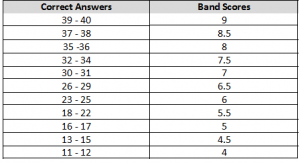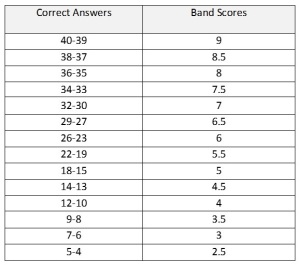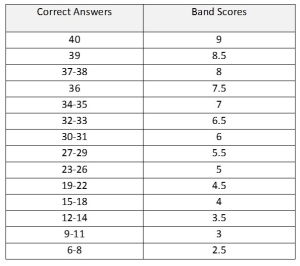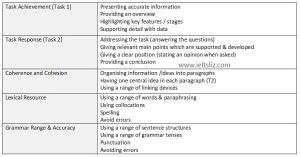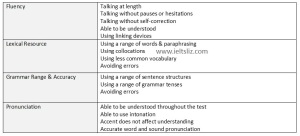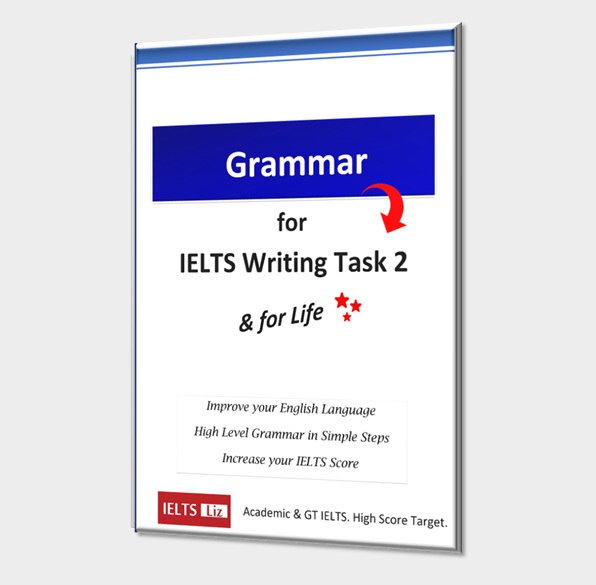The IELTS band score tables below explain the scoring to help you calculate and understand your score. Understanding the requirements for your target score is essential for success in IELTS.
How the IELTS Band Scores are Calculated
All IELTS scores are between 0 and 9. You can also get .5 scores as well (for example, 6.5 or 7.5). You will get a band score for each skill (listening, reading, writing and speaking) and also an overall band score. The overall band score is the average score of all the skills. See the table below as an example.
As explained on the IELTS website, overall test results are calculated to the nearest 0.5 or nearest whole band score. This means if the final score is not a precise 7.5 (as shown in the table above), your score is pushed to the nearest whole score or half score depending which is nearest. Below you can see examples of how this works according to IELTS:
- If your overall score is 6.1, your score will go down to 6. This is the nearest whole band score. In other words, 6.1 is closer to band 6 than to 6.5.
- If your overall score is calculated to be 6.85, your final result will be band 7. This is because 6.85 is closer to band 7 than to band 6.5.
- If your overall score is an average of 6.25, your score will be increased to 6.5. The score 6.25 is actually precisely between band 6 and 6.5, so in this case IELTS will push it up to the nearest score which is 6.5.
- If your overall score is an average of 6.75, your score will be increased to 7. This score again is precisely between 6.5 and band 7. In this case, your score will be rounded up to band 7.
- As you can see above, your score is rounded up or down to the nearest 0.5 or whole score as shown above. You can confirm this information on the official BC IELTS Website: click here.
Band Score Descriptions
The table below gives a description of each band score with information about the level of English required for band scores 5 to 9. Click table to enlarge.
To see all scores from 0-9, click here.
Listening and Reading Band Scores
Your listening and reading scores are calculated by the number of correct answers you have out of the 40 questions in the test. You do not lose points for incorrect answers.
Note: There is only one listening test for both GT and Academic candidates. This means you all take the same test with the same marking.
IELTS Listening Scores
IELTS Reading Scores (AC)
IELTS Reading Scores (GT)
IELTS Writing Assessment Criteria
Both writing task 1 and task 2 are assessed using 4 criteria. Please see the table below for details of each marking criteria.
Note: Both GT and Academic candidates will have the same marking criteria and scoring for task 2, even though the GT essay questions are often slightly easier. However, for writing task 1 GT candidates must write a letter, while Academic candidates must write a report. For this reason, marking for Task Achievement is slightly different, but for the other three criteria, the marking is the same.
Table Summary of Writing Marking Criteria
- Task Achievement / Task Response = 25%
- Coherence & Cohesion = 25%
- Vocabulary = 25%
- Grammar = 25%
Tips for Improving your IELTS Writing for each Marking Criterion:
Official IELTS Writing Task 1 and Task 2 Band Descriptors for Public Use:
IELTS Speaking Assessment Criteria
Below are the marking criteria for IELTS speaking. All candidates take the same speaking test. There is only one IELTS speaking test.
Each marking criterion counts for 25% of your marks:
You should also spend time studying the band scores for each criteria in the speaking descriptors published by IELTS.
……………………………………
.


